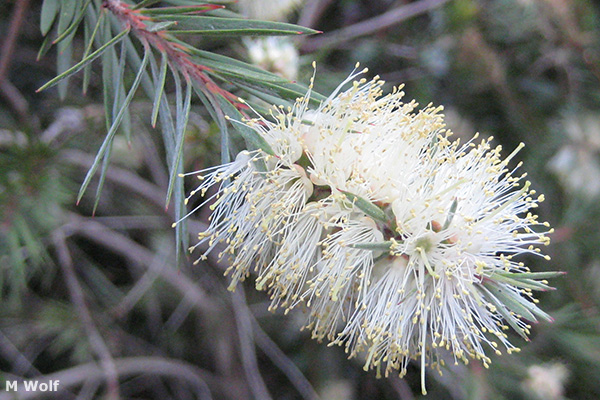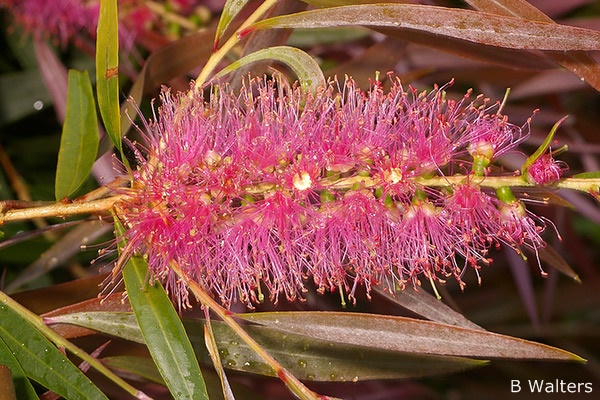General Description:
There is ongoing controversy about whether Melaleuca or Callistemon should be used for the bottlebrush species – see footnote box. Some herbaria have now adopted the name Melaleuca salicina for this species, however, this reclassification has not been adopted in the Australian Plant Census (which is accepted by ANPSA as the authority on Australian Plant nomenclature).
Callistemon salignus is usually a small tree to about 7-8 metres high with soft, pendulous foliage and papery bark. Leaves are elongated elliptical in shape to about 100 mm long by 5-15 mm wide. A pink flowered cultivar, known as “Perth Pink”, is in cultivation. It has a more bushy habit and is a smaller plant than the normal species, reaching about 3 metres high by a similar spread.
A feature of the plant is the pink/red colour of the new growth. This is a particular feature of the cultivar ‘Great Balls of Fire’, a low growing form to about 0.75 m x 0.75m.
The bottlebrush flower clusters are usually about 50 mm long and cream to white in colour (except for “Perth Pink”). Flowers occur in late spring to mid summer but some flowers may also appear in autumn.
C.salignus is well known as it has been grown in gardens and parks for many years. It is a hardy species which is suited to most soils, even those with less than perfect drainage. It grows best with adequate moisture but will tolerate extended dry periods once established.
Propagation is easy from both seed and cuttings. ‘Perth Pink, ‘Great Balls of Fire’ and other named cultivars must be propagated from cuttings to ensure that plants retain the flower colour and growth habit of the cultivars.
Craven’s re-classification has been adopted in a 2013 publication “Melaleucas: their botany, essential oils and uses” by Joseph J. Brophy, Lyndley A. Craven and John C. Doran.

Callistemon salignus
The typical white flowered form
Photo: Michael Wolf (from Wikimedia Commons and reproduced under the GNU Free Documentation License)

Callistemon salignus “Perth Pink”
Photo: Brian Walters

Callistemon salignus; “Great Balls of Fire”
Photo: Brian Walters
Other Native Plant Profiles
 Australian Native Plants Society (Australia)
Australian Native Plants Society (Australia)